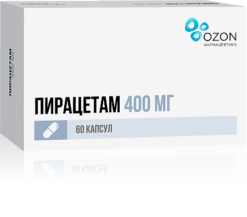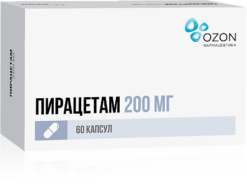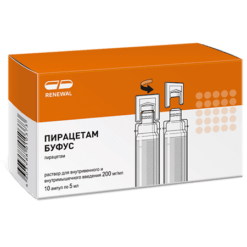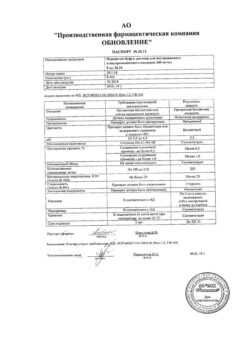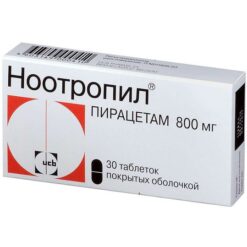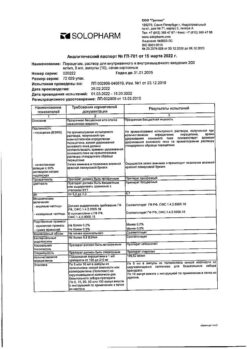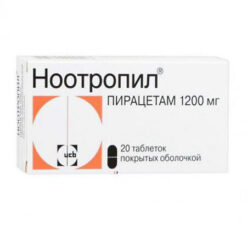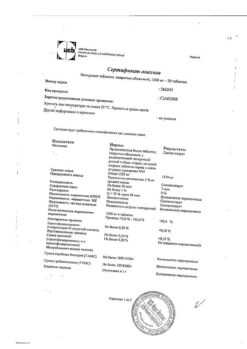No products in the cart.
Piracetam, 200 mg 60 pcs
€5.36 €4.05
Description
Pharmacotherapeutic group: Nootropic agent.
ATX code: N06BX03.
Pharmacological properties
Pharmacodynamics
The active component is piracetam, a cyclic derivative of gamma-aminobutyric acid (GABA).
The evidence suggests that the underlying mechanism of action of piracetam is not cell-specific or organ-specific.
Piracetam binds to the polar heads of phospholipids and forms mobile drug-phospholipid complexes. As a result, the two-layer structure of the cell membrane and its stability are restored, which in turn leads to restoration of the three-dimensional structure of membrane and transmembrane proteins and restoration of their function.
At the neuronal level, piracetam facilitates various types of synaptic transmission with a preferential effect on the density and activity of postsynaptic receptors (data obtained in animal studies). Piracetam improves such functions as learning, memory, attention and consciousness without any sedative or psychostimulant effects.
Hemorheological effects of Piracetam are associated with its effect on red blood cells, platelets and the vascular wall.
In patients with sickle cell anemia, piracetam increases the ability of red blood cells to deform, reduces blood viscosity and prevents the formation of “coin columns”. In addition, it reduces platelet aggregation without significantly affecting their number.
Piracetam has been shown in animal studies to inhibit vasospasm and counteract various vasospastic agents.
In studies on healthy volunteers, piracetam reduced erythrocyte adhesion to the vascular endothelium and stimulated prostacyclin production by healthy endothelium.
Pharmacokinetics
Intake.
After oral administration, piracetam is rapidly and almost completely absorbed from the gastrointestinal tract. Bioavailability of piracetam is close to 100%. After a single dose of 3.2 g, maximum concentration (Cmax) is 84 mcg/ml, after 3.2 mg 3 times daily – 115 mcg/ml, and is reached after 1 hour in plasma and after 5 hours in cerebrospinal fluid. Food intake reduces Cmax by 17% and increases the time of its achievement (Tmax) up to 1.5 hours. In women when receiving piracetam at a dose of 2.4 g the Cmax and area under the curve “concentration – time” (AUC) is 30% higher than in men.
Distribution.
The volume of distribution (Vd) is about 0.6 l/kg. Piracetam penetrates through the blood-brain barrier and the placental barrier. In animal studies it was found that piracetam selectively accumulates in the cortical tissues, mainly in the frontal, parietal and occipital lobes, in the cerebellum and basal nuclei.
Metabolism.
It does not bind to plasma proteins and is not metabolized in the body.
Elimination.
The elimination half-life (T1/2) is 4-5 hours from blood plasma and 8.5 hours from cerebrospinal fluid. The elimination half-life does not depend on the route of administration. 80-100% of piracetam is excreted unchanged by the kidneys through glomerular filtration. Total clearance of piracetam in healthy volunteers is 80-90 ml/min. T1/2 is prolonged in renal failure (up to 59 hours in terminal chronic renal failure). Pharmacokinetics
piracetam does not change in patients with hepatic impairment.
Indications
Indications
In adults:
– Symptomatic treatment of psychoorganic syndrome, in particular in elderly patients, accompanied by memory loss, dizziness, decreased concentration and decreased activity, mood changes, behavior disorder, gait disturbance (these symptoms may be early signs of age-related diseases such as Alzheimer’s disease and senile dementia of the Alzheimer’s type);
– Treatment of dizziness and associated imbalance, with the exception of vascular and psychogenic dizziness;
– Complex therapy and monotherapy for cortical myoclonus;
– Complex therapy of sickle cell anemia (for the prevention of sickle cell vaso-occlusive crisis).
In children:
– Treatment of dyslexia (in combination with other methods);
– Complex therapy of sickle cell anemia (for the prevention of sickle cell vaso-occlusive crisis).
Pharmacological effect
Pharmacological effect
Pharmacotherapeutic group: Nootropic drug.
ATX code: N06BX03.
Pharmacological properties
Pharmacodynamics
The active component is piracetam, a cyclic derivative of gamma-aminobutyric acid (GABA).
Available evidence suggests that the primary mechanism of action of piracetam is not cell-specific or organ-specific.
Piracetam binds to the polar heads of phospholipids and forms mobile drug-phospholipid complexes. As a result, the two-layer structure of the cell membrane and its stability are restored, which in turn leads to the restoration of the three-dimensional structure of membrane and transmembrane proteins and the restoration of their function.
At the neuronal level, piracetam facilitates various types of synaptic transmission, having a predominant effect on the density and activity of postsynaptic receptors (data obtained from animal studies). Piracetam improves functions such as learning, memory, attention and consciousness without causing sedation or psychostimulant effects.
The hemorheological effects of piracetam are associated with its effect on red blood cells, platelets and the vascular wall.
In patients with sickle cell anemia, piracetam increases the ability of red blood cells to deform, reduces blood viscosity and prevents the formation of “coin coins”. In addition, it reduces platelet aggregation without significantly affecting platelet count.
Animal studies have shown that piracetam inhibits vasospasm and counteracts various vasospastic substances.
In studies on healthy volunteers, piracetam reduced the adhesion of red blood cells to the vascular endothelium and stimulated the production of prostacyclins by healthy endothelium.
Pharmacokinetics
Suction.
After oral administration, piracetam is quickly and almost completely absorbed from the gastrointestinal tract. The bioavailability of piracetam is close to 100%. After a single dose of the drug in a dose of 3.2 g, the maximum concentration (Cmax) is 84 mcg/ml, after repeated doses of 3.2 mg 3 times a day – 115 mcg/ml and is achieved after 1 hour in the blood plasma and after 5 hours in the cerebrospinal fluid. Eating reduces Cmax by 17% and increases the time to reach it (Tmax) by up to 1.5 hours. In women, when taking piracetam at a dose of 2.4 g, the Cmax and area under the concentration-time curve (AUC) are 30% higher than in men.
Distribution.
The volume of distribution (Vd) is approximately 0.6 l/kg. Piracetam penetrates the blood-brain and placental barriers. In animal studies, it was found that piracetam selectively accumulates in the tissues of the cerebral cortex, mainly in the frontal, parietal and occipital lobes, in the cerebellum and basal ganglia.
Metabolism.
Does not bind to blood plasma proteins and is not metabolized in the body.
Excretion.
The half-life (T1/2) is 4-5 hours from blood plasma and 8.5 hours from cerebrospinal fluid. The half-life does not depend on the route of administration. 80-100% of piracetam is excreted unchanged by the kidneys through glomerular filtration. The total clearance of piracetam in healthy volunteers is 80-90 ml/min. T1/2 is prolonged in case of renal failure (in case of end-stage chronic renal failure – up to 59 hours). Pharmacokinetics
piracetam does not change in patients with liver failure.
Special instructions
Special instructions
When treating cortical myoclonus, abrupt interruption of treatment should be avoided, as this may cause resumption of attacks.
When treating sickle cell anemia, a dose of less than 160 mg/kg or irregular use of the drug may cause an exacerbation of the disease.
Penetrates through the filter membranes of hemodialysis machines.
Impact on the ability to drive vehicles and operate machinery
During the treatment period, care should be taken when driving vehicles and engaging in other potentially hazardous activities that require increased concentration and speed of psychomotor reactions.
Active ingredient
Active ingredient
Piracetam
Composition
Composition
One capsule contains:
active substance – piracetam – 200 mg,
excipients: stearic acid, sodium lauryl sulfate, magnesium carbonate basic,
shell composition: gelatin, glycerin, sodium lauryl sulfate, titanium dioxide (E171), purified water.
Pregnancy
Pregnancy
There have been no controlled studies of the use of the drug during pregnancy.
Piracetam penetrates the placental barrier and into breast milk.
The concentration of the drug in newborns reaches 70-90% of its concentration in the mother’s blood.
Piracetam should not be used during pregnancy.
During lactation, the issue of stopping breastfeeding should be decided.
Contraindications
Contraindications
– Individual intolerance to piracetam or pyrrolidone derivatives, as well as other components of the drug;
– Psychomotor agitation at the time of drug administration;
– Huntington’s chorea;
– Acute cerebrovascular accident (hemorrhagic stroke);
– End-stage renal failure (with creatinine clearance less than 20 ml/min);
– Children under 3 years of age.
With caution: impaired hemostasis; extensive surgical interventions; heavy bleeding; chronic renal failure (with creatinine clearance 20-80 ml/min).
Side Effects
Side Effects
From the nervous system: motor disinhibition, irritability, drowsiness, depression, asthenia, headache, insomnia, agitation, imbalance, ataxia, exacerbation of epilepsy, anxiety, hallucinations, confusion.
From the digestive system: nausea, vomiting, diarrhea, abdominal pain (including gastralgia).
Metabolism: weight gain.
On the part of the hearing organs: vertigo.
From the skin: dermatitis, itching, urticaria.
Allergic reactions: angioedema, hypersensitivity, anaphylactic reactions.
Interaction
Interaction
The possibility of changing the pharmacokinetics of piracetam under the influence of other drugs is low, because 90% of piracetam is excreted unchanged by the kidneys.
When used concomitantly with thyroid hormones, there have been reports of confusion, irritability, and sleep disturbances.
According to a published study in patients with recurrent venous thrombosis, piracetam at a dose of 9.6 g/day increases the effectiveness of indirect anticoagulants (there was a more pronounced decrease in platelet aggregation, fibrinogen levels, von Willebrand factors, blood and plasma viscosity compared with the use of indirect anticoagulants only).
In vitro, piracetam does not inhibit cytochrome P450 isoenzymes, such as CYP1A2, 2B6, 2C8, 2C9, 2C19, 2B6, 2E1 and 4A9/11 at concentrations of 142, 426 and 1422 μg/ml. At a concentration of 1422 mcg/ml, a slight inhibition of CYP2A6 (21%) and ZA4/5 (11%) was noted, however, the Ki level of these two isoenzymes is sufficient when exceeding 1422 mcg/ml, and therefore metabolic interaction with other drugs is unlikely.
Taking piracetam at a dose of 20 g/day for 4 weeks did not change the maximum serum concentration and the area under the concentration-time curve of antiepileptic drugs (carbamazepine, phenytoin, phenobarbital, valproic acid).
Co-administration with alcohol did not affect serum concentrations of piracetam; The concentration of ethanol in the blood serum did not change when taking 1.6 g of piracetam.
Overdose
Overdose
Symptoms: diarrhea mixed with blood, abdominal pain.
Treatment: in case of significant overdose, rinse the stomach or induce vomiting. Symptomatic therapy is recommended, which may include hemodialysis. There is no specific antidote. The effectiveness of hemodialysis for piracetam is 50-60%.
Storage conditions
Storage conditions
In a place protected from light at a temperature not exceeding 25 °C.
Keep out of the reach of children.
Shelf life
Shelf life
3 years.
Do not use after expiration date.
Manufacturer
Manufacturer
Update of PFC JSC, Russia
Additional information
| Shelf life | 3 years. Do not use after the expiration date. |
|---|---|
| Conditions of storage | In the dark place at a temperature not exceeding 25 ° C. Keep out of reach of children. |
| Manufacturer | Update PFC AO, Russia |
| Medication form | pills |
| Brand | Update PFC AO |
Other forms…
Related products
Buy Piracetam, 200 mg 60 pcs with delivery to USA, UK, Europe and over 120 other countries.


